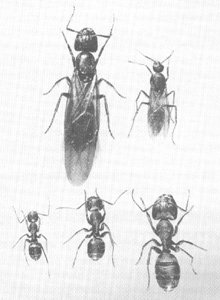Carpenter Ants
Carpenter Ant Control & Removal Information
 Size: Up to 5/8-inch long.
Size: Up to 5/8-inch long.
Colour: Varies from black, brown and black, red and black, to light brown depending on the species. The two most common pest species are black or red and black in colour.
Behaviour – Carpenter ants feed on a wide variety of foods, especially other insects. The favoured food of adults is the sweet honeydew produced by plant-feeding insects, such as aphids, scales, and mealy bugs. In the spring, mature colonies produce winged reproductive ants, called swarmers, which fly out to start new colonies. These swarms often occur from satellite colonies within homes, so homeowners may see large flying ants in their homes at night. Carpenter ants can be very difficult to control, so most homeowners employ the services of a professional company such as Kawartha Pest Control.
Habitat – Carpenter ants are the most common pest ant seen in homes throughout southern & central Ontario. The main colony must have a constant source of moisture to survive, so it is usually located in dead wood outside. This includes dead limbs, tree holes, stumps, landscape timbers, and so forth. Indoors, a main colony will have to be associated with a water leak or an overly wet, poorly ventilated crawl space or attic .The main colony may establish satellite colonies that are the primary source of ant activity inside homes. These satellite colonies may be located in any suitable void (e.g., hollow doors, curtain rods, shower rods), under attic insulation, etc. These ants set up trunk trails between the main colony to satellite colonies and between satellite colonies. Foraging ants can most easily be seen along these trunk trails at night when the ants are most active. Sometimes, the trunk trails occur beneath the ground following tree roots.
How to Prevent and Control Ants – Successfully controlling carpenter ants requires certain skills, knowledge and experience. Carpenter ant control involves tracking down and treating as many satellite colonies as possible inside and outside of the home as well as attempting to find and treat the parent colony. Accessing the parent colony may be difficult because it might be located high in a tree or on a neighbouring property. In such cases, your service professional may use carpenter ant baits, but these may have varying results because of the carpenter ants’ finicky feeding habits. If conditions on your property (such as a large number of trees) create a high risk for re-infestation, your service professional may recommend regular pest management services to help prevent new infestations
These tips will help you limit carpenter ant infestation:
– Store any firewood away from your home and remove any dead wood or wood scraps from around the foundation.
– Trim dead limbs from trees and remove stumps. Rid your yard of these potential nesting sites.
– Make sure that all plumbing or roof leaks are sealed, and check crawl spaces for excess moisture.
– Water from rain gutters should be directed away from your home and not be allowed to accumulate close to the foundation.
Call the professionals at Kawartha Pest Control or use the contact form on this page for a free no obligation quote.
